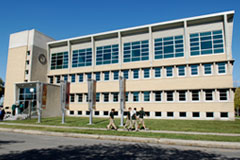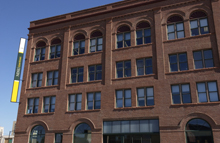Landscape Architecture
Landscape architecture is a dynamic, broad-spectrum profession that incorporates many disciplines. Geology, ecology and horticulture, architecture and engineering, geography, the social sciences and the fine arts are a few of the contributors to these “architects of the land.” The function and aesthetics of parks, housing developments, transportation corridors, urban plazas, zoos and campuses all reflect the acquired skill of landscape architects using both “hard” (built) and “soft” (planted) materials to both sustain and manipulate the natural environment. Landscape architects design exterior spaces with sketches, detail models, and working drawings for their clients as well as the companies and contractors that will use these specifications to bring life to the practitioner’s vision. The unique challenges for landscape architects span everything from small residential landscapes and large-scale urban developments to regional watersheds. Collaborating with architects, planners and engineers, landscape architects create compelling and memorable exterior spaces that affect the lives of people who inhabit them.
Career Opportunities
The majority of landscape architects work for landscape architecture services and firms, engineering, architecture and planning companies. Roughly one in five become their own entrepreneur after licensure.
The federal agencies that hire many landscape architects include the U.S. Forest Service, the National Park Service, Soil Conservation Service, the Bureau of Land Management, U.S. Army Corps of Engineers, the Department of Transportation and the Veteran’s Administration. Many of these departments also exist at a state and municipal level, providing additional work opportunities.
Within all these job possibilities exists the opportunity to apply the ethical imperatives of conservation, remediation and sustainability to increasing challenges of energy requirements.
Accreditation
The Master in Landscape Architecture program is seeking accreditation in Fall 2019. The Bachelor of Landscape Architecture program is fully accredited by the Landscape Architectural Accreditation Board (LAAB). For more information, see www.asla.org. To become a licensed landscape architect requires an accredited professional degree, internship and a state exam leading to licensure.
The Program
The landscape architecture program offers a professional five-year Master of Landscape Architecture (M.L.A.) degree. North Dakota State University landscape architecture is the only program in the region. During the first year of study, the pre-landscape architecture curriculum addresses the understanding of the environment and our impact on nature. In addition to meeting General Education and departmental requirements, students take five environmental design courses (ENVD 101, 102, 104, 130 and 172) comprised of lecture courses, a drawing course and a design fundamentals course. Beginning at the sophomore level, through a selective admissions process, students become landscape architecture majors. Studio courses are limited in enrollment to maintain a high level of student-faculty contact. The landscape architecture program is based on a studio model of education providing high contact hours between students and their professors as they learn problem-solving techniques and design methodologies. The primary focus is on design thinking, students engaging in individual and group projects that represent a wide array of design challenges. In this studio format, students have opportunities for public service projects requiring real-world solutions benefiting both the students and the ethical requirements of outreach within the profession. Other courses in the curriculum include the history of landscape architecture, grading and drainage, materials and methods, construction documentation, and professional ethics and practices. The program emphasizes the importance of critical thinking, the communication of ideas through writing, public presentation of models, drawings, renderings and computer animation. Field trips, lecture series, invited outside professionals and a laptop computer requirement in the second year help students develop their own interests and craft their own unique career path.
The program also provides a path for students who wish to pursue a Bachelor of Science (B.S.) degree in environmental design, a pre-professional degree awarded at the conclusion of four years of study. This degree may be useful for students wanting to attend a graduate program in landscape architecture at NDSU.
Activities and Facilities
The landscape architecture program activities include:
- Student chapters of the American Society of Landscape Architects, Sigma Lambda Alpha Honor Society, Freedom by Design and the U.S. Green Building Council; National Organization of Minority Architects-Students;
- Annual recruitment and career fair;
- Beaux Arts Ball and a guest speaker, both organized by students;
- Interaction with community-driven projects such as Main Street Initiatives and the National Park Service;
- Studio field trips to cities within the U.S. and Canada;
- Visiting lecturers addressing landscape architecture and related topics;
- Collaborative studio projects with the architecture program;
- Summer study opportunities in Europe, North America, and an International Student Exchange Program; and
- Summer intern opportunities.
Our facilities include:
- Two dynamic renovated buildings located in downtown Fargo – Klai Hall and Renaissance Hall;
- 3-D prototyping and printing;
- 3-D computer rendering and server farm;
- State-of-the-art computing labs;
- Computer-aided laser cutters and CNC;
- Large document printers and scanners;
- GIS, CAD and 3-D rendering and modeling software;
- An Architecture and Landscape Architecture Library of 18,000 books, 70 magazine subscriptions and 36,000 slides;
- Photographic and graphic reproduction equipment;
- Individual studio spaces, second through fifth years; and
- A professionally staffed and equipped wood shop.
High School Preparation
We suggest that students take high school courses in digital drawing and animation, art, perhaps drawing from life, math and science courses such as calculus, trigonometry, physics and biology. And, if possible, we encourage high school students to take advanced placement or college credit courses that fulfill NDSU General Education requirements.
Transfer Students
Early applications for admission is necessary for all information to be processed before the beginning of each academic year. Portfolio and official transcripts are required for faculty review (refer to Selective Admission) if freshman credits are completed for advanced placement within the Landscape Architecture program.
Selective Admission
Approximately 16 landscape architecture majors are selected for admission into the second year of the program. A student’s ranking is based on their overall grade point average (GPA) and their GPA for pre-landscape architecture courses with the ENVD prefix. It is important to apply early, complete all freshman courses in the first year, and maintain a solid academic record.
Landscape Architecture Plan of Study
Please note this is a sample plan of study and not an official curriculum. Actual student schedules for each semester will vary depending on start year, education goals, applicable transfer credit, and course availability. Students are encouraged to work with their academic advisor on a regular basis to review degree progress and customize an individual plan of study.
First Year | |||
Fall | Credits | Spring | Credits |
ENVD 101 Introduction to Environmental Design | 3 | ENVD 104 Environmental Design Fundamentals | 1 |
ENVD 102 Drawing Basics for Environmental Designers | 1 | ENVD 172 Environmental Design Fundamentals Studio | 3 |
ENVD 130 Drawing Skills for Environmental Designers | 3 | ENGL 120 College Composition II | 3 |
ENGL 110 College Composition I | 4 | COMM 110 Fundamentals of Public Speaking | 3 |
Gen Ed Science & Technology | 3 | ANTH 111 Introduction to Anthropology | 3 |
PSYC 111 or SOC 110 Introduction to Psychology | 3 | Gen Ed Quantitative Reasoning | 3 |
or Introduction to Sociology | Gen Ed Wellness | 3 | |
| 17 |
| 19 |
Second Year | |||
Fall | Credits | Spring | Credits |
LA 231 Landscape Architecture Graphics | 3 | LA 232 Design Technology | 3 |
LA 271 Introduction to Landscape Architecture Studio | 6 | LA 272 Parks & Open Spaces Studio | 6 |
ARCH 321 History and Theory of Architecture I | 3 | LA 321 History of Landscape Architecture | 4 |
PLSC 355 Woody Landscape Plants | 3 | Gen Ed Science & Technology | 3 |
| 15 |
| 16 |
Third Year | |||
Fall | Credits | Spring | Credits |
LA 331 Graphics III: Design Communication | 3 | LA 342 Site Development and Detailing II | 4 |
LA 341 Site Development and Detailing I | 4 | LA 372 Community Planning & Design Studio | 6 |
LA 371 Site Planning & Design Studio | 6 | ENGL 326 or 357 Writing in the Design Professions | 3 |
Gen Ed Science & Technology | 3 | or Visual Culture and Language |
|
Gen Ed Science & Technology Lab | 1 | Elective/Minor | 3 |
| 17 |
| 16 |
Fourth Year | |||
Fall | Credits | Spring | Credits |
LA 471 Urban Design Studio | 6 | LA 441 Site Development and Detailing III | 4 |
LA 722 Advanced Landscape Planning* | 3 | LA 472 or ARCH 474 Remediation & Planting Design Studio | 6 |
Elective/Minor | 4 | LA 590 Seminar | 3 |
Elective/Minor | 3 | Elective/Minor | 3 |
| 16 | 16 | |
Fifth Year | |||
Fall | Credits | Spring | Credits |
LA 763 Programming and Thesis Preparation | 3 | LA 772 Design Thesis | 6 |
LA 771 Environmental Planning Studio | 6 | LA 789 Seminar or Elective/Minor | 3 |
LA 781 Professional Practice | 3 | Elective/Minor | 3 |
LA 789 Seminar | 3 | Elective/Minor | 3 |
| 15 |
| 15 |
Total Credits: 161 | |||
* Recommended for fourth-year students
View NDSU equivalencies of transfer courses at: www.ndsu.edu/transfer/equivalencies

Klai Hall
Room 108
Klai Hall is located in downtown Fargo at 711 2nd Ave. N. (Campus Map)

NDSU Downtown
Art, Architecture & Landscape Architecture Administrative Office Room 105
NDSU Downtown is located in downtown Fargo at 650 NP Ave. (Campus Map)
Contact Information
Landscape Architecture
NDSU Dept 2352
PO Box 6050
Fargo, ND 58108-6050
Phone: (701) 231-6151
Email:matthew.kirkwood@ndsu.edu
Web: www.ndsu.edu/ala/
or
Office of Admission
North Dakota State University
Ceres 114
Dept #5230, PO Box 6050
Fargo, ND 58108-6050
Tel: (701) 231-8643 / Fax: (701) 231-8802
Email: NDSU.Admission@ndsu.edu
Web: www.ndsu.edu/admission/
10/20